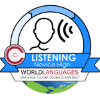CCSD Curriculum Elements
Click on the images below to learn more about language expectations and download the domain or level specific Student Self-Assessment Checklists documents.
| Performace Description |
Domain | Level |
 |
|
|
I can present information on most familiar topics using a series of simple sentences. |
|
I can talk about people, activities, events, and experiences. · I can describe the physical appearance of a friend or family member. · I can describe another person’s personality. · I can describe a school or workplace. · I can describe a famous place. · I can describe a place I have visited or want to visit. · I can present my ideas about something I have learned.
I can express my needs and wants. · I can describe what I need for school or work. · I can talk about what I want or need to do each day.
I can present information on plans, instructions, and directions. · I can explain the rules of a game. · I can give multi-step instructions for preparing a recipe. · I can describe what my plans are for the weekend. · I can describe what my summer plans are. · I can describe holiday or vacation plans. · I can describe what is needed for a holiday or a celebration. · I can describe what I plan to do next in my life. I can present songs, short skits, or dramatic readings. · I can retell a children’s story. · I can present a proverb, poem, or nursery rhyme. · I can participate in a performance of a skit or a scene from a play.
I can express my preferences on topics of interest. · I can give a presentation about a movie or television show that I like. · I can give a presentation about a famous athlete, celebrity, or historical figure. · I can express my thoughts about a current event I have · learned about or researched |
- Details
- Category: Language Proficiency
- Hits: 2038
Click on the images below to learn more about language expectations and download the domain or level specific Student Self-Assessment Checklists documents.
| Performace Description |
Domain | Level |
 |
|
|
|
|
I can make a presentation about my personal and social experiences. · I can describe a childhood or past experience. · I can report on a social event that I attended. · I can make a presentation on something new I learned. · I can make a presentation about my plans for the future. I can make a presentation on smething I have learned or researched. · I can give a short presentation on a current event. · I can present about a topic from an academic subject, such as science, math, art, etc. · I can describe how to plan and carry out an event, such as a party or family reunion. · I can give a short presentation on a famous person, landmark, or cultural event. I can make a presentation about common interests and issues and state my viewpoint. · I can give a presentation about a favorite movie or song and tell why I like it. · I can give a presentation about a famous person or historical figure and tell why he/she is important. · I can share my reactions about a current event and explain why the event is in the news.
|
- Details
- Category: Language Proficiency
- Hits: 1990
Click on the images below to learn more about language expectations and download the domain or level specific Student Self-Assessment Checklists documents.
| Performace Description |
Domain | Level |
 |
|
|
|
|
I can present information on academic and work topics. · I can present ideas about something I have learned, such as a historical event, a famous person, or a current environmental issue. · I can explain a series of steps needed to complete a task or experiment. · I can explain to someone who was absent what took place in class or on the job. · I can present my qualifications and goals for an academic program, training, or job. I can make a presentation on events, activities, and topics of particular interest. · I can present on something I learned from the media. · I can make a presentation about an interesting person. · I can summarize a personal, historical, or cultural event. · I can give a presentation about my interests, hobbies, lifestyle, or preferred activities. · I can make a presentation about the history or current status, of a school, organization, or company. · I can make a presentation about future plans. I can present my point of view and provide reasons to support it. · I can make a presentation on rules or policies such as cell phone use, dress code, or requirements for driving and explain my viewpoint. · I can share and justify my opinion on common issues such as allowances for children, curfews for teenagers, budget-related topics, etc. · I can explain my point of view on current event topics such as recycling, nutrition. · I can explain my point of view on current event topics such as recycling, nutrition and exercise, the food supply, conserving energy resources, extreme weather events, etc
|
- Details
- Category: Language Proficiency
- Hits: 1996
Culture
Interact with cultural competence and understanding. The study of culture and language is strongly interconnected. Students use the language to investigate and interact properly with the practices, perspectives, and products of the various cultures.
| LEVELS | |||
| Novice |  |
 |
 |
| Intermediate |  |
 |
 |
| Advanced |  |
 |
 |
- Details
- Category: Language Proficiency
- Hits: 2670
Communication
To share or exchange information, news, or ideas effectively in more than one language in order to function in a variety of situations and for multiple purposes.
 Interpersonal Communication
Interpersonal Communication
Learners interact and negotiate meaning in spoken, signed, or written conversations to share information, reactions, feelings, and opinions.
Click HERE to download the Interpersonal Communication Self-Assessment Checklist.
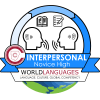 |
Novice:
Expresses self in conversations on very familiar topics using a variety of words, phrases, simple sentences, and questions that have been highly practiced and memorized. |
 |
Intermediate: Expresses self and participates in conversations on familiar topics using sentences and series of sentences. Handles short social interactions in everyday situations by asking and answering a variety of questions. Can communicate about self, others, and everyday life. |
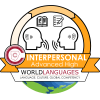 |
Advanced: Expresses self fully to maintain conversations on familiar topics and new concrete social, academic, and work-related topics. Can communicate in paragraph- length conversation about events with detail and organization. Confidently handles situations with an unexpected complication. Shares point of view in discussions. |
American Council of Teaching of Foreign Languages (ACTFL)
- Details
- Category: Language Proficiency
- Hits: 4436
Communication
To share or exchange information, news, or ideas effectively in more than one language in order to function in a variety of situations and for multiple purposes.
 Interpretive Communication
Interpretive Communication
Learners understand, interpret, and analyze what is heard, read, or viewed on a variety of topics.
| Click the icons below to download the Interpretive Communication Self-Assessment Checklists. | Click the icons below to see the proficiency guidelines for each level. | ||
| Interpretive Listening |
Novice |
Intermediate | Advanced |
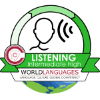 |
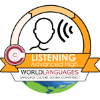 |
||
| Interpretive Reading | |||
 |
 |
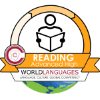 |
|
American Council of Teaching of Foreign Languages (ACTFL)
- Details
- Category: Language Proficiency
- Hits: 4030
The language proficiency targets indicate what students are expected to do with the language at the end of each course in terms of producing language (speaking and writing), understanding language (listening and reading), and interacting with others in the language. Proficiency targets for each language are based on the American Council on the Teaching of Foreign Languages (ACTFL) Proficiency Guidelines.
Click on each of the headings for details on the target skills for each level.
Level |
|
|
|
|
|
Level I |
Novice Low |
Novice Mid |
Novice Low |
Novice Mid |
Novice Low |
Level II |
Novice Mid |
Novice Mid (+) |
Novice Mid |
Novice Mid (+) |
Novice Mid |
Level III |
Novice Mid (+) |
Novice High |
Novice Mid (+) |
Novice High |
Novice Mid (+) |
Level IV |
Novice High |
Intermediate Low |
Novice High |
Intermediate Low |
Novice High |
Level V - VIII |
Intermediate Low (-) to Intermediate High (-) |
Intermediate Mid (-) to Intermediate High |
Intermediate Low (-) to Intermediate High (-) |
Intermediate Mid (-) to Intermediate High |
Intermediate Low (-) to Intermediate High (-) |
- Details
- Category: Language Proficiency
- Hits: 5419
The language proficiency targets indicate what students are expected to do with the language at the end of each course in terms of producing language (Expresive and Glossing), understanding language (Receptive and Finger Spelling), and interacting with others in the language. Proficiency targets for each language are based on the American Council on the Teaching of Foreign Languages (ACTFL) Proficiency Guidelines.
Click on each of the headings for details on the target skills for each level.
Level |
Interpersonal
|
Presentational
|
Presentational
|
Interpretive |
Interpretive
|
Level I |
Novice Mid |
Novice Mid |
Novice Low |
Novice High |
Novice Mid |
Level II |
Novice High |
Novice High |
Novice Mid |
Intermediate Low |
Novice High |
Level III |
Intermediate Low (-) |
Intermediate Low (-) |
Novice High |
Intermediate Mid (-) |
Intermediate Low (-) |
Level IV |
Intermediate Low |
Intermediate Low |
Intermediate Low |
Intermediate Mid |
Intermediate Low |
Level V - VIII |
Intermediate Mid to Advanced Low |
Intermediate Mid to Advanced Low |
Intermediate Mid to Advanced Low |
Intermediate High (-) to Advanced Low |
Intermediate Mid to Advanced Low |
- Details
- Category: Language Proficiency
- Hits: 4449
The language proficiency targets indicate what students are expected to do with the language at the end of each course in terms of producing language (speaking and writing), understanding language (listening and reading), and interacting with others in the language. Proficiency targets for each language are based on the American Council on the Teaching of Foreign Languages (ACTFL) Proficiency Guidelines.
Click on each of the headings for details on the target skills for each level.
Level |
|
|
|
|
|
Level I |
Novice Low |
Novice Mid |
Novice Low |
Novice Mid |
Novice Low |
Level II |
Novice Mid |
Novice Mid (+) |
Novice Mid |
Novice Mid (+) |
Novice Mid |
Level III |
Novice Mid (+) |
Novice High |
Novice Mid (+) |
Novice High |
Novice Mid (+) |
Level IV |
Novice High |
Intermediate Low |
Novice High |
Intermediate Low |
Novice High |
Level V - VIII |
Intermediate Low (-) to Intermediate High (-) |
Intermediate Mid (-) to Intermediate High |
Intermediate Low (-) to Intermediate High (-) |
Intermediate Mid (-) to Intermediate High |
Intermediate Low (-) to Intermediate High (-) |
- Details
- Category: Language Proficiency
- Hits: 5333
The language proficiency targets indicate what students are expected to do with the language at the end of each course in terms of producing language (speaking and writing), understanding language (listening and reading), and interacting with others in the language. Proficiency targets for each language are based on the American Council on the Teaching of Foreign Languages (ACTFL) Proficiency Guidelines.
Click on each of the headings for details on the target skills for each level.
|
Level |
||||||
|
7th Grade |
Novice Mid |
Novice Mid |
Novice Mid |
Novice Mid |
Novice High |
Novice |
|
Level I |
Novice High |
Novice High |
Novice High |
Novice High |
Intermediate Low |
Novice |
|
Level II |
Intermediate Low |
Intermediate Low |
Intermediate Low |
Intermediate Low |
Intermediate Mid (-) |
Intermediate (-) |
|
Level III |
Intermediate Mid (-) |
Intermediate Mid (-) |
Intermediate Mid (-) |
Intermediate Mid (-) |
Intermediate Mid |
Intermediate (-) |
|
Level IV |
Intermediate Mid |
Intermediate Mid |
Intermediate Mid |
Intermediate Mid |
Intermediate |
Intermediate |
|
Level V - VIII |
Intermediate High (-) to Advanced Low |
Intermediate High (-) to Advanced Low |
Intermediate High (-) to Advanced Low |
Intermediate High (-) to Advanced Low |
Intermediate High to Advanced Low |
Advanced |
Learn more about ACTFL's Language Proficiency Guidelines and the NCSSFL-ACTFL Global CAN-DO Benchmark Statements.
- Details
- Category: Language Proficiency
- Hits: 6280
The language proficiency targets indicate what students are expected to do with the language at the end of each course in terms of producing language (speaking and writing), understanding language (listening and reading), and interacting with others in the language. Proficiency targets for each language are based on the American Council on the Teaching of Foreign Languages (ACTFL) Proficiency Guidelines.
Click on each of the headings for details on the target skills for each level.
Level |
|
|
|
|
|
Level I |
Novice High |
Novice High |
Novice High |
Novice High |
Intermediate Low |
Level II |
Intermediate Low |
Intermediate Low |
Intermediate Low |
Intermediate Low |
Intermediate Mid (-) |
Level III |
Intermediate Mid (-) |
Intermediate Mid (-) |
Intermediate Mid (-) |
Intermediate Mid (-) |
Intermediate Mid |
Level IV |
Intermediate Mid |
Intermediate Mid |
Intermediate Mid |
Intermediate Mid |
Intermediate High (-) |
Level V - VIII |
Intermediate High (-) to Advanced Low |
Intermediate High (-) to Advanced Low |
Intermediate High (-) to Advanced Low |
Intermediate High (-) to Advanced Low |
Intermediate High to Advanced Low |
Learn more about ACTFL's Language Proficiency Guidelines and the NCSSFL-ACTFL Global CAN-DO Benchmark Statements.
- Details
- Category: Language Proficiency
- Hits: 5794
The language proficiency targets indicate what students are expected to do with the language at the end of each course in terms of producing language (speaking and writing), understanding language (listening and reading), and interacting with others in the language. Proficiency targets for each language are based on the American Council on the Teaching of Foreign Languages (ACTFL) Proficiency Guidelines.
Click on each of the headings for details on the target skills for each level.
Level |
|
|
|
|
|
Level I |
Novice Low |
Novice Mid |
Novice Low |
Novice Mid |
Novice Low |
Level II |
Novice Mid |
Novice Mid (+) |
Novice Mid |
Novice Mid (+) |
Novice Mid |
Level III |
Novice Mid (+) |
Novice High |
Novice Mid (+) |
Novice High |
Novice Mid (+) |
Level IV |
Novice High |
Intermediate Low |
Novice High |
Intermediate Low |
Novice High |
Level V - VIII |
Intermediate Low (-) to Intermediate High (-) |
Intermediate Mid (-) to Intermediate High |
Intermediate Low (-) to Intermediate High (-) |
Intermediate Mid (-) to Intermediate High |
Intermediate Low (-) to Intermediate High (-) |
- Details
- Category: Language Proficiency
- Hits: 4738
The language proficiency targets indicate what students are expected to do with the language at the end of each course in terms of producing language (speaking and writing), understanding language (listening and reading), and interacting with others in the language. Proficiency targets for each language are based on the American Council on the Teaching of Foreign Languages (ACTFL) Proficiency Guidelines.
Click on each of the headings for details on the target skills for each level.
Level |
|
|
|
|
|
Level I |
Novice High |
Novice High |
Novice High |
Novice High |
Intermediate Low |
Level II |
Intermediate Low |
Intermediate Low |
Intermediate Low |
Intermediate Low |
Intermediate Mid (-) |
Level III |
Intermediate Mid (-) |
Intermediate Mid (-) |
Intermediate Mid (-) |
Intermediate Mid (-) |
Intermediate Mid |
Level IV |
Intermediate Mid |
Intermediate Mid |
Intermediate Mid |
Intermediate Mid |
Intermediate High (-) |
Level V - VIII |
Intermediate High (-) to Advanced Low |
Intermediate High (-) to Advanced Low |
Intermediate High (-) to Advanced Low |
Intermediate High (-) to Advanced Low |
Intermediate High to Advanced Low |
Learn more about ACTFL's Language Proficiency Guidelines and the NCSSFL-ACTFL Global CAN-DO Benchmark Statements.
- Details
- Category: Language Proficiency
- Hits: 4460
The language proficiency targets indicate what students are expected to do with the language at the end of each course in terms of producing language (speaking and writing), understanding language (listening and reading), and interacting with others in the language. Proficiency targets for each language are based on the American Council on the Teaching of Foreign Languages (ACTFL) Proficiency Guidelines.
Click on each of the headings for details on the target skills for each level.
|
Level |
||||||
| K-5th Grade DLI - Bilingual |
Intermediate Mid |
Intermediate Mid |
Intermediate Mid |
Intermediate High |
Intermediate Mid |
Intermediate (-) |
|
6th Grade |
Novice Low |
Novice Low |
Novice Low |
Novice Low |
Novice Mid |
Novice |
|
7th Grade |
Novice Mid |
Novice Mid |
Novice Mid |
Novice Mid |
Novice High |
Novice |
|
Level I |
Novice High |
Novice High |
Novice High |
Novice High |
Intermediate Low |
Novice |
|
Level II |
Intermediate Low |
Intermediate Low |
Intermediate Low |
Intermediate Low |
Intermediate Mid (-) |
Intermediate (-) |
|
Level III |
Intermediate Mid (-) |
Intermediate Mid (-) |
Intermediate Mid (-) |
Intermediate Mid (-) |
Intermediate Mid |
Intermediate (-) |
|
Level IV |
Intermediate Mid |
Intermediate Mid |
Intermediate Mid |
Intermediate Mid |
Intermediate |
Intermediate |
|
Level V - VIII |
Intermediate High (-) to Advanced Low |
Intermediate High (-) to Advanced Low |
Intermediate High (-) to Advanced Low |
Intermediate High (-) to Advanced Low |
Intermediate High to Advanced Low |
Advanced |
|
Native Speakers I |
Intermediate High (-) |
Intermediate High (-) |
Intermediate Low |
Intermediate High |
Intermediate Low |
Intermediate (-) |
|
Native Speakers II |
Advanced Low (-) | Advanced Low (-) | Intermediate High (-) |
Advanced Low (-) | Intermediate High (-) |
Intermediate |
|
Native Speakers III |
Advanced Low | Advanced Low | Intermediate High |
Advanced Low | Intermediate High |
Advanced (-) |
Learn more about ACTFL's Language Proficiency Guidelines and the NCSSFL-ACTFL Global CAN-DO Benchmark Statements.
- Details
- Category: Language Proficiency
- Hits: 9332
At the Advanced level, listeners can understand the main ideas and most supporting details in connected discourse on a variety of general interest topics, such as news stories, explanations, instructions, anecdotes, or travelogue descriptions. Listeners are able to compensate for limitations in their lexical and structural control of the language by using real-world knowledge and contextual clues. Listeners may also derive some meaning from oral texts at higher levels if they possess significant familiarity with the topic or context.
Advanced-level listeners understand speech that is authentic and connected. This speech is lexically and structurally uncomplicated. The discourse is straightforward and is generally organized in a clear and predictable way
Advanced-level listeners demonstrate the ability to comprehend language on a range of topics of general interest. They have sufficient knowledge of language structure to understand basic time-frame references. Nevertheless, their understanding is most often limited to concrete, conventional discourse.
 Advanced High
Advanced High
At the Advanced High sublevel, listeners are able to understand, with ease and confidence, conventional narrative and descriptive texts of any length as well as complex factual material such as summaries or reports. They are typically able to follow some of the essential points of more complex or argumentative speech in areas of special interest or knowledge. In addition, they are able to derive some meaning from oral texts that deal with unfamiliar topics or situations. At the Advanced High sublevel, listeners are able to comprehend the facts presented in oral discourse and are often able to recognize speaker-intended inferences. Nevertheless, there are likely to be gaps in comprehension of complex texts dealing with issues treated abstractly that are typically understood by Superior-level listeners.
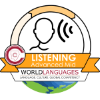 Advanced Mid
Advanced Mid
At the Advanced Mid sublevel, listeners are able to understand conventional narrative and descriptive texts, such as expanded descriptions of persons, places, and things, and narrations about past, present, and future events. The speech is predominantly in familiar target-language patterns. Listeners understand the main facts and many supporting details. Comprehension derives not only from situational and subject-matter knowledge, but also from an increasing overall facility with the language itself.
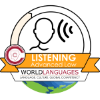 Advanced Low
Advanced Low
At the Advanced Low sublevel, listeners are able to understand short conventional narrative and descriptive texts with a clear underlying structure though their comprehension may be uneven. The listener understands the main facts and some supporting details. Comprehension may often derive primarily from situational and subject-matter knowledge.
For additional information go to
ACTFL PROFICIENCY GUIDELINES 2012
- Details
- Category: Language Proficiency
- Hits: 9306
Subcategories
Page 2 of 3














